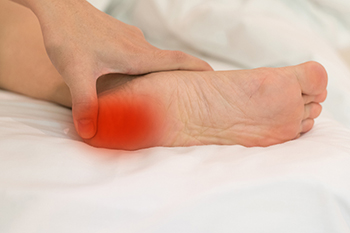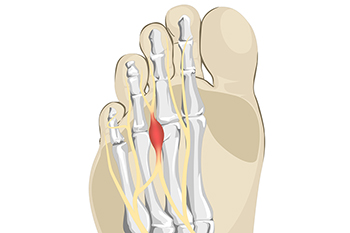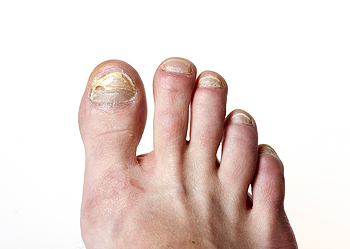

Heel pain is often associated with the condition known as plantar fasciitis. This common form of heel pain is the result of damage to, and inflammation of, the plantar fascia. The plantar fascia is the connective tissue on the sole of the foot that inserts at the heel bone, then spreads up to support the arch, and fans out to connect with each toe. Damage to the plantar fascia may be caused by wear from old age, obesity, shoes with inadequate support, and increasing physical activity too rapidly. Among the other causes are training on hard surfaces, standing for prolonged periods of time, and having flat feet or high arches. Plantar fasciitis typically causes pain in the inner/center part of the heel that worsens after periods of rest. Your podiatrist can offer various treatments to repair the plantar fascia, while reducing inflammation and pain. It is suggested that you contact one to seek treatment, as this condition may become chronic if the tissue does not heal properly.
Plantar fasciitis is a common foot condition that is often caused by a strain injury. If you are experiencing heel pain or symptoms of plantar fasciitis, contact Dr. Alan J. Spector from Shore Podiatry. Our doctor can provide the care you need to keep you pain-free and on your feet.
What Is Plantar Fasciitis?
Plantar fasciitis is one of the most common causes of heel pain. The plantar fascia is a ligament that connects your heel to the front of your foot. When this ligament becomes inflamed, plantar fasciitis is the result. If you have plantar fasciitis you will have a stabbing pain that usually occurs with your first steps in the morning. As the day progresses and you walk around more, this pain will start to disappear, but it will return after long periods of standing or sitting.
What Causes Plantar Fasciitis?
There are some risk factors that may make you more likely to develop plantar fasciitis compared to others. The condition most commonly affects adults between the ages of 40 and 60. It also tends to affect people who are obese because the extra pounds result in extra stress being placed on the plantar fascia.
Prevention
There are a variety of treatment options available for plantar fasciitis along with the pain that accompanies it. Additionally, physical therapy is a very important component in the treatment process. It is important that you meet with your podiatrist to determine which treatment option is best for you.
If you have any questions, please feel free to contact our office located in Point Pleasant, NJ . We offer the newest diagnostic and treatment technologies for all your foot care needs.

As a parent or guardian, you may wonder if your young child’s stance or gait is normal as they learn how to stand and walk. As your child grows, most issues will work themselves out, but there are some things you should monitor. When babies are born, they do not have arches, which is known as having flat feet. Typically, by the time a child is 6 years old, their arch is developed and visible when they stand. Around the age of 4, many children will have a small gap between their ankles when standing with their knees together (knock knees) which should go away by the age of 6 or 7 when their legs straighten out fully. If the gap is between both their knees and ankles, this is known as bow legs. This condition is commonly present in children less than 18 months old. Some young children walk on their tiptoes (tiptoe walking) until approximately 3 years of age, and thereafter will usually adopt the normal heel-to-toe walking pattern. Feet that turn in (in-toeing) or turn out (out-toeing) will usually start pointing straight by themselves when the child is roughly 8 years old. Regular check-ups with a podiatrist will help ensure that your child’s feet are developing normally. Also, if the issues mentioned here do not go away on their own, or you have any concerns about your child’s foot or ankle health, have your child examined by a podiatrist right away.
The health of a child’s feet is vital to their overall well-being. If you have any questions regarding foot health, contact Dr. Alan J. Spector of Shore Podiatry. Our doctor can provide the care you need to keep you pain-free and on your feet.
Tips for Keeping Children's Feet Healthy
If you have any questions, please feel free to contact our office located in Point Pleasant, NJ . We offer the newest diagnostic and treatment technologies for all your foot care needs.

The pain from a foot condition that is known as Morton’s neuroma is generally found in the ball of the foot. A neuroma is another name for a pinched nerve or nerve tumor. It is often benign, and can grow and spread to other nerves in the foot. It is an ailment that affects the nerves between the third and fourth toes, and can cause severe pain and discomfort. Many patients describe the pain as feeling like a pebble or marble under the foot, and possibly cause difficulty in completing daily activities. Common reasons for this condition to develop can include frequently wearing high heels, and participating in running and jumping activities that can compress the feet in shoes. Additionally, medical conditions consisting of bunions and hammertoes may lead to getting Morton’s neuroma. A proper diagnosis consists of having a CT scan taken, or possibly an MRI. Many people have found mild relief when specific foot stretches are performed, and it can be beneficial to wear shoes that fit correctly. These types of shoes will have adequate room for the toes to move freely in, and this can help to achieve full range of motion and flexibility. Morton’s neuroma can be painful, and can hinder the ability to complete daily tasks. If you have pain in this part of your foot, it is suggested you consult with a podiatrist who can accurately diagnose and treat Morton’s neuroma.
Morton’s neuroma is a very uncomfortable condition to live with. If you think you have Morton’s neuroma, contact Dr. Alan J. Spector of Shore Podiatry. Our doctor will attend to all of your foot care needs and answer any of your related questions.
Morton’s Neuroma
Morton's neuroma is a painful foot condition that commonly affects the areas between the second and third or third and fourth toe, although other areas of the foot are also susceptible. Morton’s neuroma is caused by an inflamed nerve in the foot that is being squeezed and aggravated by surrounding bones.
What Increases the Chances of Having Morton’s Neuroma?
Morton’s neuroma is a very treatable condition. Orthotics and shoe inserts can often be used to alleviate the pain on the forefront of the feet. In more severe cases, corticosteroids can also be prescribed. In order to figure out the best treatment for your neuroma, it’s recommended to seek the care of a podiatrist who can diagnose your condition and provide different treatment options.
If you have any questions, please feel free to contact our office located in Point Pleasant, NJ . We offer the newest diagnostic and treatment technologies for all your foot care needs.

Getting a toenail infection can be easy, mainly because the fungus that causes it is very contagious. Spotting it is also easy. Infected toenails may change color to white, yellow, brown or green. They may become thickened, raise up off the toe, or crumble. Luckily, a number of simple precautions can help to keep fungal infections at bay. First, protect your feet by wearing shower slippers at pools, public showers, spas or gym locker rooms, all of which are common breeding grounds for fungi. If you have recently had a fungal infection, don’t wear shoes or slippers you wore during that time. Change your socks when they get sweaty. Keep your feet clean and dry, and wear canvas or mesh shoes that allow your feet to breathe. Give your shoes at least 24 hours to dry out before wearing them again. Avoid sharing personal items, such as nail clippers, shoes or towels, that may have picked up a fungus. Keep your feet moisturized, as fungi can enter through cracks or sores in the skin. Finally, be vigilant and check your toenails at least once a month for symptoms. If you need help in dealing with toenail infections, please consult a podiatrist.
If left untreated, toenail fungus may spread to other toenails, skin, or even fingernails. If you suspect you have toenail fungus it is important to seek treatment right away. For more information about treatment, contact Dr. Alan J. Spector of Shore Podiatry. Our doctor can provide the care you need to keep you pain-free and on your feet.
Symptoms
Treatment
If self-care strategies and over-the-counter medications does not help your fungus, your podiatrist may give you a prescription drug instead. Even if you find relief from your toenail fungus symptoms, you may experience a repeat infection in the future.
Prevention
In order to prevent getting toenail fungus in the future, you should always make sure to wash your feet with soap and water. After washing, it is important to dry your feet thoroughly especially in between the toes. When trimming your toenails, be sure to trim straight across instead of in a rounded shape. It is crucial not to cover up discolored nails with nail polish because that will prevent your nail from being able to “breathe”.
In some cases, surgical procedure may be needed to remove the toenail fungus. Consult with your podiatrist about the best treatment options for your case of toenail fungus.
If you have any questions, please feel free to contact our office located in Point Pleasant, NJ . We offer the newest diagnostic and treatment technologies for all your foot care needs.